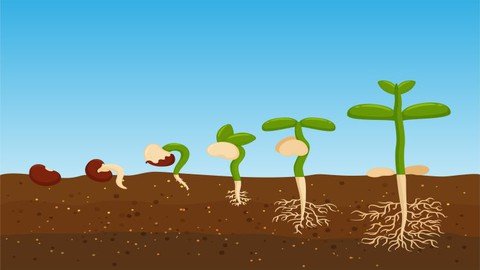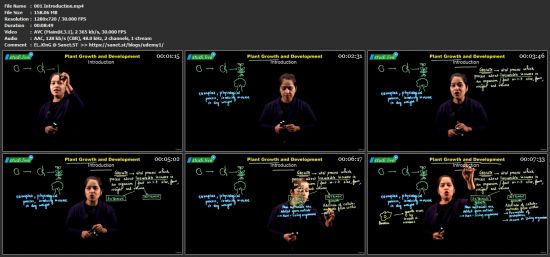Biology : Plant Growth & Development
This post was published 2 years ago. Download links are most likely obsolete. If that's the case, try asking the uploader to re-upload.

MP4 | Video: h264, 1280x720 | Audio: AAC, 44.1 KHz
Language: English | Size: 2.77 GB | Duration: 2h 43m
18 Lessons | 2hr 43min. | State Board , CBSE & ICSE | Competitive exams like NEET , CET, Foundation
What you'll learn
Growth
Differentiation, Dedifferentiation and Redifferentiation
Development
Plant Growth Regulators
Photoperiodism
Vernalisation
Requirements
Basic understanding of Biology
Description
Description
Growth is one of the most conspicuous events in any living organism. It is an irreversible increase expressed in parameters such as size, area, length, height, volume, cell number etc. It conspicuously involves increased protoplasmic material. In plants, meristems are the sites of growth. Root and shoot apical meristems sometimes alongwith intercalary meristem, contribute to the elongation growth of plant axes. Growth is indeterminate in higher plants. Following cell division in root and shoot apical meristem cells, the growth could be arithmetic or geometrical.
Growth may not be and generally is not sustained at a high rate throughout the life of cell/tissue/organ/organism. One can define three principle phases of growth – the lag, the log and the senescent phase. When a cell loses the capacity to divide, it leads to differentiation. Differentiation results in development of structures that is commensurate with the function the cells finally has to perform. General principles for differentiation for cell, tissues and organs are similar. A differentiated cell may dedifferentiate and then redifferentiate. Since differentiation in plants is open, the
development could also be flexible, i.e., the development is the sum of growth and differentiation. Plant exhibit plasticity in development.
Plant growth and development are under the control of both intrinsic and extrinsic factors. Intercellular intrinsic factors are the chemical substances, called plant growth regulators (PGR). There are diverse groups of PGRs in plants, principally belonging to five groups: auxins, gibberellins, cytokinins, abscisic acid and ethylene. These PGRs are synthesised in various parts of the plant; they control different
differentiation and developmental events. Any PGR has diverse physiological effects on plants. Diverse PGRs also manifest similar effects. PGRs may act synergistically or antagonistically. Plant growth and development is also affected by light, temperature, nutrition, oxygen status, gravity and such external factors.
Flowering in some plants is induced only when exposed to certain duration of photoperiod. Depending on the nature of photoperiod requirements, the plants are called short day plants, long day plants and day-neutral plants. Certain plants also need to be exposed to low temperature so as to hasten flowering later in life. This treatement is known as vernalisation.
Who this course is for
Biology enthusiast.
Beginners in Biology.
NEET & MHT-CET aspirants
Those preparing for board and competitive exams State Board, CBSE, ICSE , IGCSE, MHT-CET & NEET
Screenshots
Homepage
without You and Your Support We Can’t Continue
Thanks for Buying Premium From My Links for Support
Click >>here & Visit My Blog Daily for More Udemy Tutorial. If You Need Update or Links Dead Don't Wait Just Pm Me or Leave Comment at This Post
Download from free file storage
Resolve the captcha to access the links!
Registered members don't get captcha ... just sayin
